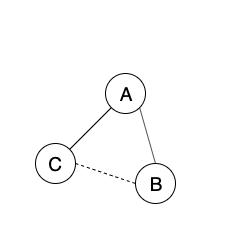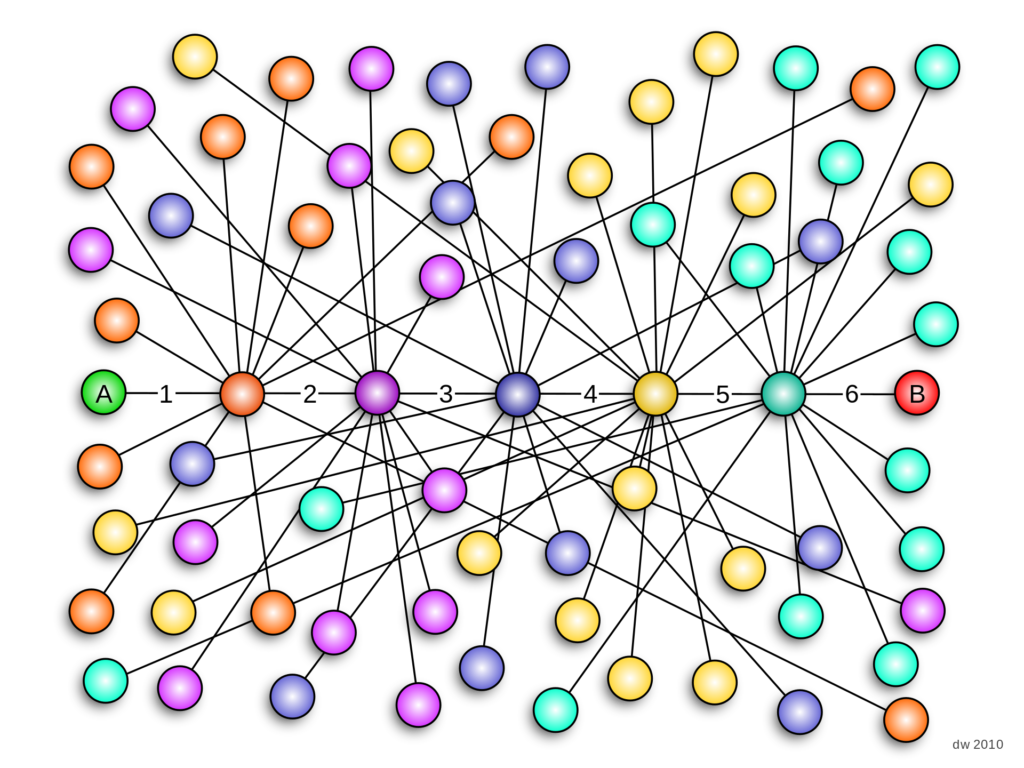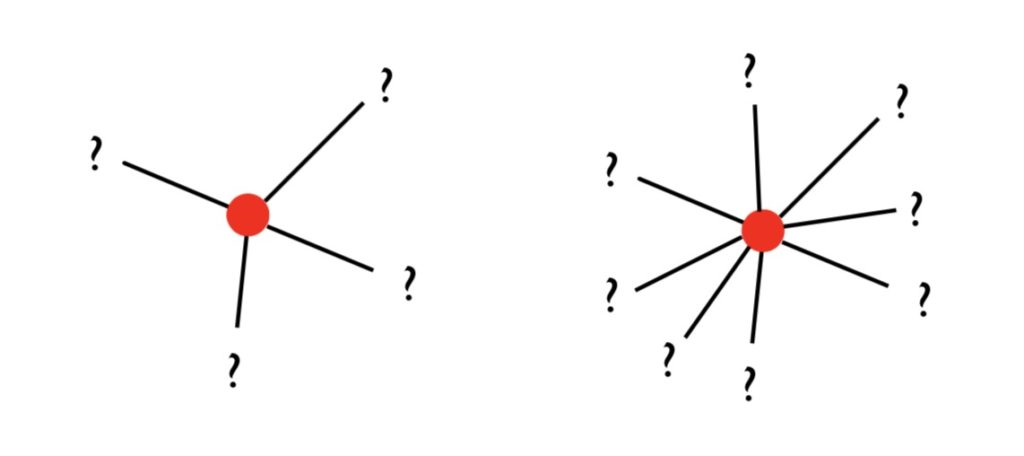Friendship takes up a significant portion of our social network, a good friendship can enrich our lives as well as increase your chances of happiness as an adult. However, we are not taught much about how to form a friendship. Indeed, building a relationship with someone is difficult, there are lots of factors need to be taken account of, such as education level, distance, age etc. Nevertheless, there is at least one essential requirement: You have to share something in common with that person.

Have you ever noticed how Facebook’s “People You May Know” just got creepier? In fact, If two people in a social network have a mutual friend, there lies a reasonable probability that these two people might become friends at some point in the future, this is called the triadic closure.

The dashed line indicates that B and C might potentially build a relationship. What’s more interesting behind our social network is that if we randomly choose two people across the world, we only need six or fewer people (nodes) to construct a social connection between them. On April 24, 2019, a blog on exploring your mind called “The Six Degrees of Separation Theory” by Angélica interested me. This idea was originally set out by Frigyes Karinthy in 1929 and popularized in an eponymous 1990 play written by John Guare. It is sometimes generalized to the average social distance being logarithmic in the size of the population.

The theory claimed that due to the ever-increasing network connectedness caused by technology, our world is “shrinking”. That is, even if the physical distance among two arbitrary individuals is great, the rapidly growing density of human networks made the actual social distance far smaller. If we consider a person as a node in the social network, and the number of friends they have as edges, it is not hard to imagine if a node has an extremely high node degree, then it is connected to many other nodes on the graph with a path.

In the context of CSCC46, we know that the probability that a random pair of nodes are connected on the graph is determined by the clustering coefficient, which is the quotient of the number of edges between the neighbours of a node and the degree of that node. And the average clustering coefficient is the sum of all nodes’ clustering coefficient divide by the total number of nodes. We can reveal that Karinthy’s hypothesis is true in today’s digital era. Every time when we like a post on Facebook, a video on YouTube or an image on Instagram, we somehow established a digital connection on the network, and we perform these actions constantly without realizing it. When there is more and more such digital connection on our social network, the clustering coefficient for each node increases and resulting in a higher chance that two random nodes are connected.
A social network is not only a matter of friendship, but it can also be applied to many other fields such as Theoretical Biology. José Carlos Santos & Sérgio Matos did an infodemiology study that evaluates the use of Twitter messages and searches engine query logs to estimate and predict the incidence rate of influenza-like illness in Portugal. And Vasileios Lampos proposed a method to track flu in the population using social networks. He first identified a set selected keywords to be looked for in Twitter posts, and collect a set of daily twitters, if any keyword is found in the tweet, it will be marked as 1 and 0 otherwise, and a set of equations turning statistical information into flu-score for different regions and areas.
There is still many myths about the social networks that we have not revealed its veil yet. For example, the friend paradox: people tend to have fewer friends than their friends, and homophily: the tendency for people to have (non-negative) ties with people who are similar to themselves in socially significant ways. In today’s era, it is not surprising to believe that the idea of six degrees of separation is true, and it has been several decades since this topic was popularized, who knows what number of degrees it will be now, maybe it is the same or smaller.
Reference:
Alessa, Ali, and Miad Faezipour. “A Review of Influenza Detection and Prediction through Social Networking Sites.” SpringerLink, BioMed Central, 1 Feb. 2018, https://link.springer.com/article/10.1186/s12976-017-0074-5.
Angélica. “The Six Degrees of Separation Theory and How It Works.” Exploring Your Mind, Exploring Your Mind, 23 Apr. 2019, https://exploringyourmind.com/the-six-degrees-of-separation-theory/.
Carlos, José, and Sérgio Matos1. “Analysing Twitter and Web Queries for Flu Trend Prediction.” Theoretical Biology and Medical Modelling, BioMed Central, 7 May 2014, https://tbiomed.biomedcentral.com/articles/10.1186/1742-4682-11-S1-S6.
Frei, Lukas. “Predicting Friendship.” Medium, Towards Data Science, 11 Feb. 2019, https://towardsdatascience.com/predicting-friendship-a82bc7bbdf11.
“Homophily.” Software, http://www.analytictech.com/mgt780/topics/homophily.htm.
Morse, Gardiner. “The Science Behind Six Degrees.” Harvard Business Review, 1 Aug. 2014, https://hbr.org/2003/02/the-science-behind-six-degrees.
Silver, Curtis. “How Facebook’s ‘People You May Know’ Section Just Got Creepier.” Forbes, Forbes Magazine, 11 Oct. 2017, https://www.forbes.com/sites/curtissilver/2016/06/28/how-facebooks-people-you-may-know-section-just-got-creepier/#47b743245f5a.
“Six Degrees of Separation.” Wikipedia, Wikimedia Foundation, 25 Sept. 2019, https://en.wikipedia.org/wiki/Six_degrees_of_separation.
“Tracking the Flu Pandemic by Monitoring the Social Web.” Tracking the Flu Pandemic by Monitoring the Social Web, Institute of Electrical and Electronics Engineers, 2019, https://ieeexplore.ieee.org/abstract/document/5604088.
